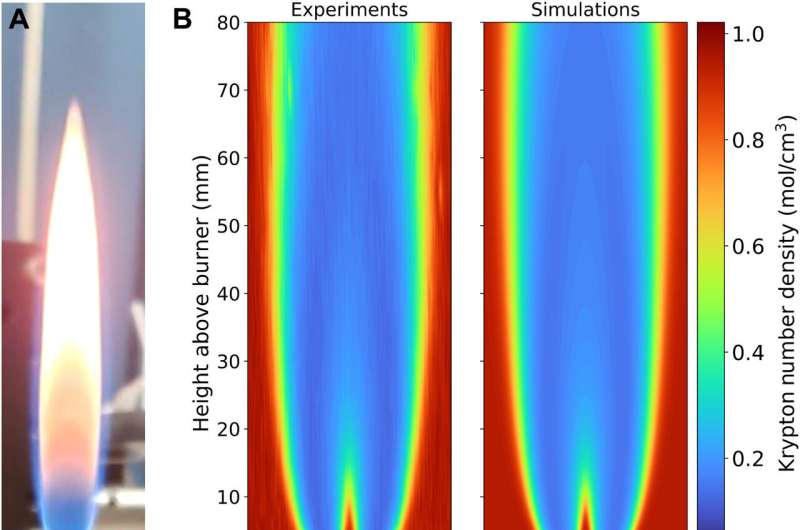New technique to measure temperatures in combustion flames could lead to cleaner biofuels

A new X-ray technique to measure temperatures in combustion flames could lead to cleaner biofuels.
Understanding the dynamics of combustion of biofuels—fuels made from plants, algae or animal waste—is essential for building clean, efficient biofuel-powered engines. An important driver of these dynamics is temperature.
Scientists from the U.S. Department of Energy's (DOE) Argonne National Laboratory, Yale University and Penn State University have refined and used an X-ray technique to measure temperatures in an extremely hot, soot-laden flame produced by combustion. Such measurements have historically been challenging. The new technique can potentially help reduce emissions from biofuel-powered engines. The study was published in Science Advances.
A need to optimize biofuels
Reducing emissions of greenhouse gases and other pollutants due to fossil fuel combustion will require major changes in energy systems. The U.S. Energy Information Administration reports that there are well over a billion fossil-powered vehicles worldwide, projecting that the conventional vehicle fleet will peak in 2038.
Advanced, cleaner-burning biofuels can potentially help reduce pollutants in the meantime. This is particularly true for airplanes, ships and other heavy-duty vehicles that remain difficult to electrify with current technologies.
But developing new combustion systems for advanced biofuels is no easy task. A key barrier has been accurately measuring temperatures in flames produced by biofuel combustion. Temperatures are critical inputs in the models that researchers use to simulate combustion flames and their emissions.
"Temperature has a big influence on chemical reaction rates in flames," said Alan Kastengren, an Argonne physicist who was one of the authors of the study. "If the models don't have accurate temperatures, they're probably not predicting the chemistry correctly. Better combustion models allow researchers to design better combustion systems—whether it be internal combustion engines or electricity generation systems."
Measuring temperatures with X-rays and krypton atoms
Measuring flame temperatures is surprisingly difficult. Researchers have previously used lasers and other devices to evaluate flames. However, the soot particles present in flames can interfere with their ability to measure temperature.
X-rays are largely unaffected by soot particles, so another possibility is to use X-ray beams for flame analysis. The Argonne, Yale and Penn State researchers used and refined a technique known as X-ray fluorescence. The technique involved several steps. First, they introduced a small amount of the gas krypton into a flame comprised of air and methane (a primary component of natural gas). This is a standard flame used by laboratories worldwide in combustion research. Krypton is an element with an extremely low reactivity, so it does not change the flame's chemistry.
Next, at Argonne's Advanced Photon Source (APS), a DOE Office of Science user facility, the researchers bombarded the flame with high-energy X-ray beams. In response, the krypton atoms gave off X-rays with a unique amount of energy in a process called fluorescence. The team then used an X-ray spectrometer to detect the energy of the emitted X-ray fluorescence. This enabled the researchers to map the presence of krypton atoms and quantify their density throughout the flame. Then, the team calculated temperatures in different parts of the flame, using an equation known as the ideal gas law that relates temperature and density.
A key to the experiment's success was using the ultrabright X-ray beams at the APS. X-ray beams generated by facilities such as the APS have a much greater intensity and much more focused beams than those created in laboratories.
"A lab-scale X-ray source is kind of like a light bulb. The X-ray beams go out in all directions," said Kastengren. "With synchrotrons, the X-ray beams are all going in the same direction. That makes it much easier for us to use the beam effectively to measure the interactions with the flame."
Many ways to apply the technique
While the researchers refined the X-ray technique using a methane flame, the methods can be applied to measure temperatures in other flames, including those produced by biofuel combustion. That can help improve the accuracy of the models used to simulate flames in biofuel combustion systems. More robust models can potentially enable discoveries of new ways to operate airplane engines, gas turbines and other energy-generating systems so that they are more efficient and have lower emissions.
"Imagine switching airplanes from standard fuel to sustainable aviation fuel," said Robert Tranter, an Argonne senior chemist and an author of the study. "You need to understand the impact of that switch on the combustion properties in the engine to ensure that it operates properly. Physical testing of new fuels in a real-world engine is very expensive. Accurate combustion models can screen fuels to help determine when to do those tests."
More broadly, the X-ray methods can advance understanding of fundamental aspects of combustion, supporting a wide range of research areas. For example, they can inform efforts to develop systems that burn hydrogen to produce energy. They can help with research on the use of flames to create silicon nanoparticles, which have potential applications in medicine, batteries and other fields.
The technique can even be applied beyond combustion research. It can potentially support any laboratory experiments that require accurate temperature measurements in hostile environments.
"We're always encountering different systems where researchers need accurate temperature measurements," said Tranter. "We're open to collaboration with them."
In addition to Kastengren and Tranter, the authors are Matthew J. Montgomery, Yale; Hyunguk Kwon, Penn State; Lisa D. Pfefferle, Yale; Travis Sikes, Argonne; Yuan Xuan, Penn State and Charles S. McEnally, Yale.
More information: Matthew J. Montgomery et al, In situ temperature measurements in sooting methane/air flames using synchrotron x-ray fluorescence of seeded krypton atoms, Science Advances (2022). DOI: 10.1126/sciadv.abm7947
Journal information: Science Advances
Provided by Argonne National Laboratory




















